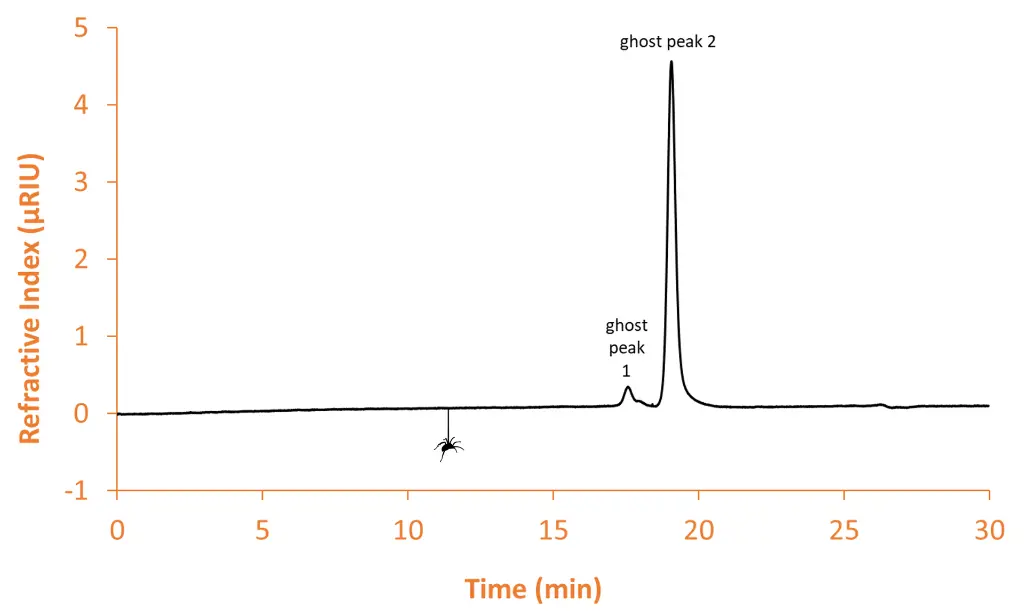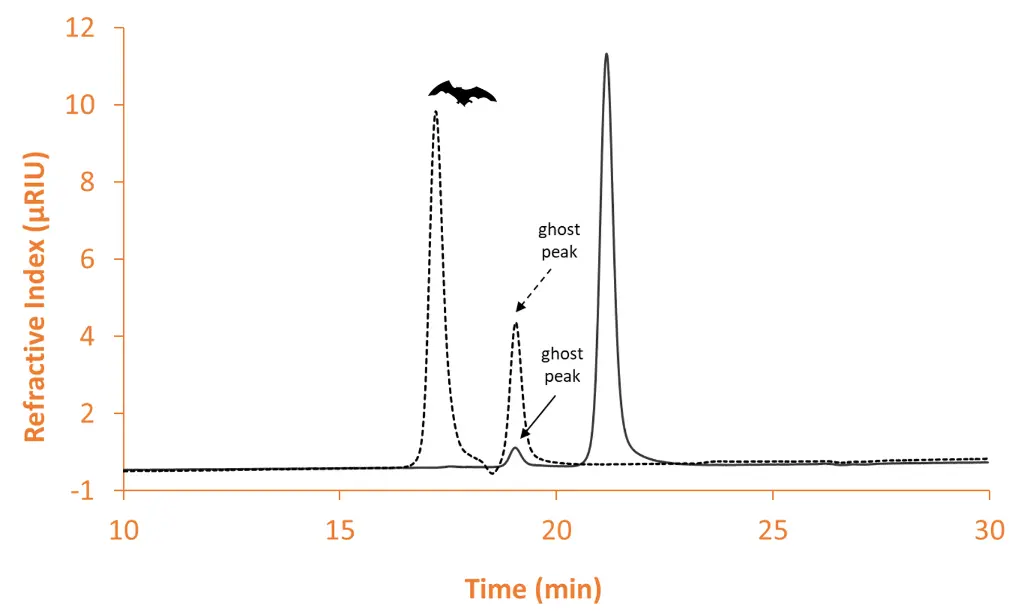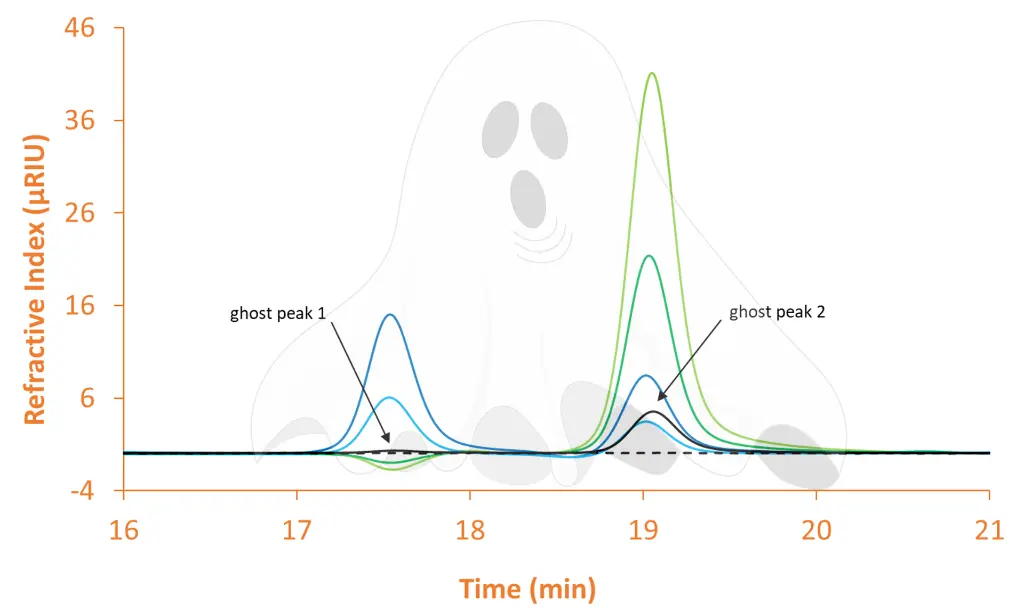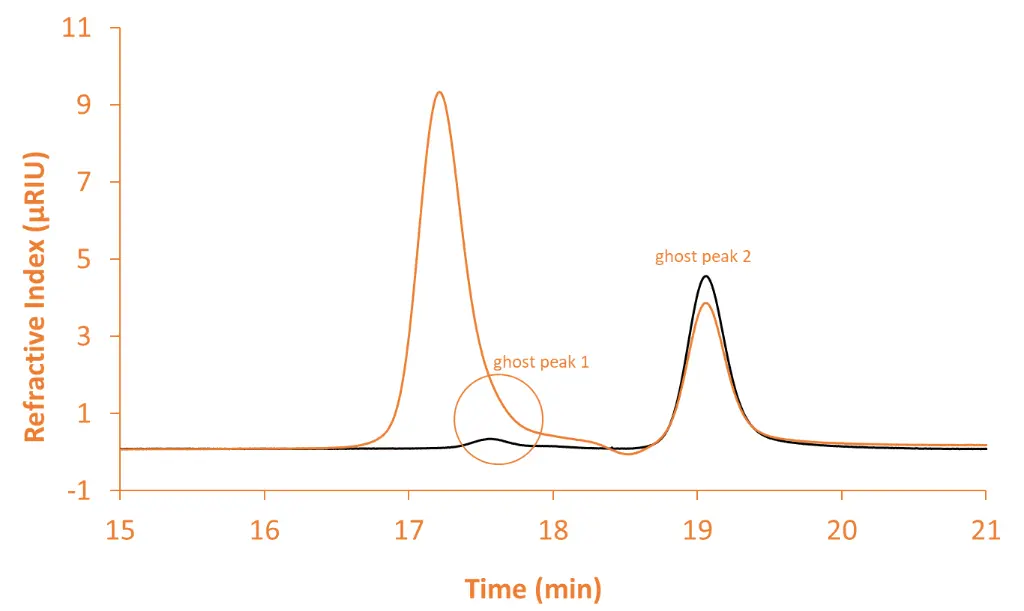Haunted by ghosts!
Even in chromatography, things aren’t always as they seem, especially around Halloween 🎃! If you have ever run a Liquid Chromatography (LC) or Gel Permeation Chromatography/Size Exclusion Chromatography (GPC/SEC) analysis and seen strange signals appear out of nowhere, then you have found your own chromatographic ghosts. These unexpected peaks can complicate your data interpretation and make even the most experienced chromatographer's shiver. But don’t fear! These ghost peaks aren’t supernatural. In this Halloween special, you will understand their origin, learn how to minimize these signals, and find out how to unmask them.
👻What are ghost peaks?
If your chromatogram shows more peaks than you can directly assign to the analytes, then you are observing ghost peaks [1]. These ghost peaks, also called system peaks appear when the balance between the mobile and stationary phase is temporarily disrupted [1]. This can for example happen when a sample is injected [1] [2]. Especially when using refractive index (RI) detection, these peaks become clearly visible even when injecting pure mobile phase (see Fig. 1). In GPC/SEC, these peaks often appear at the end of the chromatogram which marks the transition between size-based and interaction-based separation [2]. They can look deceptively like analyte signals and even overlap with them.

Fig. 1 Chromatogram of a 20 µl blank injection with RI detection. Graphic by KNAUER.
👁️How to minimize ghost peaks?
Ghost peaks can show up as positive or negative signals. While their retention time is generally constant, their peak shape, height and area can vary a lot depending on what gets injected and how much (see Fig. 2). That's why they shouldn't be used as flow markers in GPC/SEC.

Fig. 2 Overlay chromatograms measured with RID and 20 µl injection volume. Dotted black: citric acid; solid black: ethylene glycol. Graphic by KNAUER.
If you want to minimise them, make sure you dissolve the samples in the mobile phase of the system, stick to small injection volumes and give the system enough time to equilibrate [2]. You can't completely get rid of ghost peaks, so it's important to spot and correctly assign them for reliable data evaluation. Otherwise, those ghosts might trick you into making false conclusions!
🧪 How to unmask ghost peaks?
To identify and better understand ghost peaks, it is helpful to prepare each mobile phase additive separately, spike them individually into the mobile phase, and inject them one by one. Fig. 3 shows the results from an aqueous SEC run using PBS as the mobile phase. By comparing the chromatograms of the individual additives with that of the blank injection using the mobile phase (see Fig. 3), it is possible to link each ghost peak to the specific mobile phase component (NaCl, KCl, KH₂PO₄, Na₂HPO₄). This approach not only provides deeper insight into the origin of your ghost peaks but also helps you optimize your method by changing the buffer salts or their concentrations.

Fig. 3 Overlay chromatograms measured with RID and 20 µl injection volume. Black: blank (mobile phase = PBS); light green: sodium chloride; dark green: potassium chloride; light blue: potassium dihydrogen phosphate; dark blue: disodium hydrogen phosphate. Graphic by KNAUER.
Further to unmask ghost peaks in your sample, start with a blank injection using your mobile phase and then overlay it with your sample chromatogram. Peaks that show up in both with the same retention time are your ghosts. Figures 4A and 4B show overlays from an aqueous SEC run with PBS as the mobile phase and either citric acid or ethylene glycol as sample. Blank injections revealed two small peaks detected by the RI detector (see Fig. 1 and Fig. 4). For citric acid, you still see only two clear peaks instead of three, because the first ghost peak elutes right alongside the analyte, giving it a tiny shoulder (Fig. 4A). This highlights the importance of recognizing ghost peaks during data analysis to ensure accurate interpretation. By contrast, ethylene glycol behaves as expected, showing three distinct peaks (Fig. 4B). Here the analyte signal itself isn’t affected, but identifying the ghost peaks is crucial to correctly evaluate the true analyte peak.


Fig. 4 Left (4a): Overlay of chromatograms recorded with the RID using a 20 µL injection volume. Orange: citric acid; black: blank (mobile phase = PBS). Right (4b): Overlay of chromatograms recorded with the RID using a 20 µL injection volume. Orange: ethylene glycol; black: blank (mobile phase = PBS). Graphic by KNAUER.
This Halloween 🕷️, don’t be afraid of the ghosts in your chromatogram! Identify and understand them to keep your analysis reliable so even the spookiest peaks don’t lead to false conclusions.
If you’d like to learn more about detecting and minimizing system or ghost peaks in practice, take a look at our Technical Note VTN0046 on identifying and reducing system peaks in GPC/SEC.
If you're planning to set up or optimize your GPC/SEC workflow, feel free to contact us at sales@knauer.net. Stay tuned for more exciting insights into the GPC/SEC world in our “GPC/SEC Made Easy” series.
For further information on this topic, please contact our author: wesolowski@knauer.net
[1] Srbek J., Coufal P., Bosáková Z. & Tesařová E. (2005). System peaks and their positive and negative aspects in chromatographic techniques. Journal Of Separation Science, Vol. 28 (12), 1263 - 1270.
[2] Held D. & Gores F. (2019). Tips & Tricks GPC/SEC: System Peaks or Ghost Peaks in GPC/SEC. LCGC International. https://www.chromatographyonline.com/view/tips-tricks-gpcsec-system-peaks-or-ghost-peaks-gpcsec (Last access: 21.10.2025).

